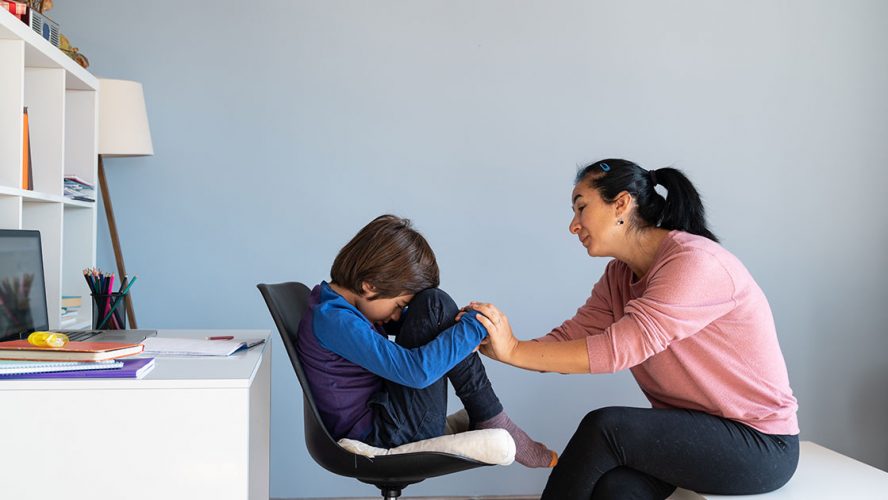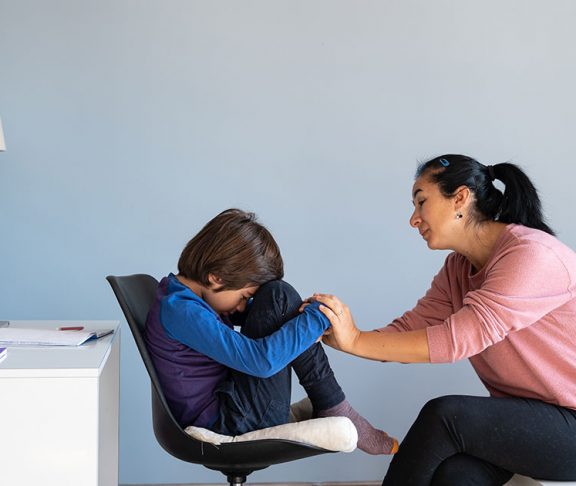When Lys Severtson’s 10-year-old son started experiencing depression, the family considered therapy. But wait times to schedule an appointment were nine months.
“I kind of got discouraged,” says Severtson, who like many parents wanted to help her child, but felt stuck by a system that wasn’t easy to navigate.
Rady Children’s Hospital-San Diego — a nationally ranked children’s hospital — has launched a Primary Care Mental Health Integration program, training pediatricians to screen youth for mental health problems and referring those patients for treatment with an embedded therapist in the primary care practice.
In the past decade, Rady Children’s has seen a 1,700 percent increase in mental health emergency department visits. Hospital inpatient stays can become a vicious cycle and kids don’t get the long-term mental health help needed. Then when discharged home, there may be long wait times for therapy. To address this growing youth mental health crisis, Rady Children’s is taking a multi-pronged approach, including recently opening its Copley Psychiatric Emergency Department in 2020.
“The vast majority of children that are coming to our emergency department are kids with suicidal thoughts or kids that have attempted suicide,” says Ben Maxwell, M.D., medical director of inpatient psychiatry and interim director of child and adolescent psychiatry at Rady Children’s.
Rady Children’s is taking a new approach to identify needs and provide intervention early.
“Our goal is to really treat the whole child — that idea of there is no health without mental health,” says Dr. Maxwell. “That psychological well-being impacts physical well-being.”
Emotional well-being
This innovative program integrates mental health therapists to work alongside pediatricians in primary care offices to vastly increase access to mental health care. The program, offered at select Children’s Primary Care Medical Group (CPCMG) and Children’s Physicians Medical Group (CPMG) locations, is a new model of care that’s designed to improve youth emotional well-being.
While pediatricians treat patients from birth to age 21, they typically didn’t have mental health training, until now. Rady Children’s is providing pediatric primary care providers access to an intensive three-day training on behavioral health management and is already halfway to a goal of training 150 providers this year.
The hallmark is having an integrated health therapist (IHT) embedded in the primary care office. The IHT works closely with pediatricians so kids can have access to medical and behavioral health services in one, familiar location. That streamlines and destigmatizes finding care, too.
“It’s a team-based approach,” says Hilary Bowers, M.D., lead pediatrician, who oversees behavioral health services at all 29 of the CPCMG locations.
When patients need help, she connects them to the in-office therapist: “You’re now transferring the trust that the family has in you as a pediatrician to that therapist, that therapeutic relationship starts off at a higher level.”
One family
Dr. Maxwell says pre-pandemic, young people already faced social isolation from spending so much time on devices. During the pandemic, distance learning left them even more isolated.
At Severtson’s son’s annual checkup, the pediatrician’s office conducted a depression screening. Through the program, he immediately started short-term in-office mental health counseling. The therapist gave him actionable tools to start feeling better right away. He also met with a psychiatrist and is taking medication for his depression.
How do you incorporate mental and behavioral health into primary care?
This new way of addressing kids’ mental health was a game changer. After just three weeks, Severtson noticed a significant improvement.
“It’s a feeling of relief. It’s a feeling of appreciation that this exists,” she says, noting the coordinated care plan is helping the fifth grader return to his smiling self.
Early intervention
Rady Children’s primary care mental health integration program relies on funding from private philanthropists. The program, which can be a model for children’s mental health, can be replicated at other facilities across the country.
“The earlier you intervene, the earlier you provide therapeutic services, the better the outcomes,” says Dr. Bowers.
To learn more about this initiative at Rady Children’s, visit www.rchsd.org/tmh


